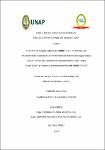| dc.contributor.advisor | Cubas Guerra, Rossana | |
| dc.contributor.advisor | Murrieta Morey, Germán Augusto | |
| dc.contributor.author | Pasquel Pinedo, Carmen Patricia | |
| dc.date.accessioned | 2024-04-02T17:52:54Z | |
| dc.date.available | 2024-04-02T17:52:54Z | |
| dc.date.issued | 2023 | |
| dc.identifier.other | 636.089696 P27 2023 | |
| dc.identifier.uri | https://hdl.handle.net/20.500.12737/9977 | |
| dc.description.abstract | The present research was carried out between June and December 2022, and its objective was to evaluate the effect of aqueous extract of Zingiber officinale in the control of parasitosis in Colossoma macropomum and Piaractus brachypomus fry. A total of 268 fry were collected and conditioned in the laboratory of Parasitology and Aquaculture Health at the Peruvian Amazon Research Center - IIAP. For its antiparasitic effect, the efficacy of concentrations of 0, 25, 50 and 75 mg/ml of aqueous extract was tested in in vitro tests and tolerance in in vivo tests with 30-minute baths. The results of the study showed that the highest percentage of efficacy was in treatment 3 (75 mg/ml) in Colossoma macropomum with 89.55% effectiveness and Piaractus brachypomus with 90.72% effectiveness. In relation to the parasite load was reduced to 90% for Colossoma macropomum and 80% for Piaractus brachypomus after exposure to the aqueous extract of Zingiber officinale, also, the tolerance tests in Colossoma macropomum the LC50 was 78.57 mg/ml and in Piaractus brachypomus it was 79.17 mg/ml. On the other hand, it was determined that the aqueous extract does not alter the physical and chemical parameters of the water and they are maintained in acceptable ranges for the species under study. It is concluded that the phytotherapeutic used to control parasitosis in Colossoma macropomum and Piaractus brachypomus shows an antiparasitic effect, which is attributed to the exposure time and concentration of the producto. | en_US |
| dc.description.abstract | La presente investigación se realizó entre junio y diciembre de 2022, el objetivo fue evaluar el efecto del extracto acuoso de Zingiber officinale en el control de parasitosis en alevinos de Colossoma macropomum y Piaractus brachypomus. Se colectaron y acondicionaron 268 alevinos en el laboratorio de Parasitología y Sanidad Acuícola en las instalaciones del centro de Investigaciones de la Amazonía Peruana- IIAP. Para su efecto antiparasitario se probó la eficacia de las concentraciones de 0, 25, 50 y 75 mg/ml de extracto acuoso en pruebas in vitro y la tolerancia en pruebas in vivo con baños de 30 minutos. Los resultados del estudio mostraron que el mayor porcentaje de eficacia fue en el tratamiento 3 (75 mg/ml) en Colossoma macropomum con 89.55% de efectividad y Piaractus brachypomus con 90.72% de efectividad. En relación a la carga parasitaria se redujo a un 90% para Colossoma macropomum y 80% para Piaractus brachypomus después de la exposición al extracto acuoso de Zingiber officinale, asimismo, las pruebas de tolerancia en Colossoma macropomum la CL50 fue de 78.57 mg/ml y en Piaractus brachypomus fue 79.17 mg/ml. Por otro lado, se determinó que el extracto acuoso no altera los parámetros físicos y químicos del agua y se mantienen en sus rangos aceptables para las especies en estudio. Se concluye que el fitoterapéutico usado para controlar la parasitosis en Colossoma macropomum y Piaractus brachypomus demuestra tener efecto antiparasitario lo que se le atribuye al tiempo de exposición y la concentración del producto. | es_PE |
| dc.format | application/pdf | es_PE |
| dc.language.iso | spa | es_PE |
| dc.publisher | Universidad Nacional de la Amazonía Peruana | es_PE |
| dc.rights | info:eu-repo/semantics/openAccess | * |
| dc.rights.uri | https://creativecommons.org/licenses/by/4.0/ | * |
| dc.subject | Parásitos | es_PE |
| dc.subject | Monogenea | es_PE |
| dc.subject | Antiparasitarios | es_PE |
| dc.subject | Kión | es_PE |
| dc.subject | Zingiber officinale | es_PE |
| dc.subject | Alevines | es_PE |
| dc.subject | Gamitana | es_PE |
| dc.subject | Colossoma macropomum | es_PE |
| dc.subject | Paco | es_PE |
| dc.subject | Piaractus brachypomus | es_PE |
| dc.title | Efecto de Zingiber officinale “kión” en el control de parasitosis causadas por Monogenoideos (monogenoidea) en alevinos de Colossoma macropomum (cuvier, 1816) “gamitana” y Piaractus brachypomus (cuvier,1818) “paco” | es_PE |
| dc.type | info:eu-repo/semantics/bachelorThesis | es_PE |
| thesis.degree.discipline | Acuicultura | es_PE |
| thesis.degree.grantor | Universidad Nacional de la Amazonía Peruana. Facultad de Ciencias Biológicas | es_PE |
| thesis.degree.name | Biólogo(a) Acuicultor(a) | es_PE |
| dc.subject.ocde | https://purl.org/pe-repo/ocde/ford#4.01.08 | es_PE |
| renati.author.dni | 72466777 | |
| renati.advisor.orcid | https://orcid.org/0000-0002-3745-4861 | |
| renati.advisor.orcid | https://orcid.org/0000-0001-6244-2654 | |
| renati.advisor.dni | 05260037 | |
| renati.advisor.dni | 42855767 | |
| renati.type | https://purl.org/pe-repo/renati/type#tesis | es_PE |
| renati.discipline | 831016 | es_PE |
| renati.level | https://purl.org/pe-repo/renati/level#tituloProfesional | es_PE |
| renati.juror | Ríos Isern, Enrique | |
| renati.juror | Del Águila Chávez, Javier | |
| renati.juror | García Ruiz, Luis | |
| dc.publisher.country | PE | es_PE |





